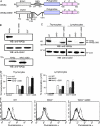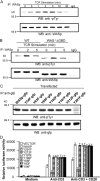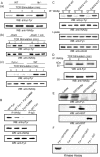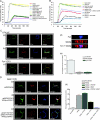Fyn and PTP-PEST-mediated regulation of Wiskott-Aldrich syndrome protein (WASp) tyrosine phosphorylation is required for coupling T cell antigen receptor engagement to WASp effector function and T cell activation
- PMID: 14707117
- PMCID: PMC1887720
- DOI: 10.1084/jem.20030976
Fyn and PTP-PEST-mediated regulation of Wiskott-Aldrich syndrome protein (WASp) tyrosine phosphorylation is required for coupling T cell antigen receptor engagement to WASp effector function and T cell activation
Abstract
Involvement of the Wiskott-Aldrich syndrome protein (WASp) in promoting cell activation requires its release from autoinhibitory structural constraints and has been attributed to WASp association with activated cdc42. Here, however, we show that T cell development and T cell receptor (TCR)-induced proliferation and actin polymerization proceed normally in WASp-/- mice expressing a WASp transgene lacking the cdc42 binding domain. By contrast, mutation of tyrosine residue Y291, identified here as the major site of TCR-induced WASp tyrosine phosphorylation, abrogated induction of WASp tyrosine phosphorylation and its effector activities, including nuclear factor of activated T cell transcriptional activity, actin polymerization, and immunological synapse formation. TCR-induced WASp tyrosine phosphorylation was also disrupted in T cells lacking Fyn, a kinase shown here to bind, colocalize with, and phosphorylate WASp. By contrast, WASp was tyrosine dephosphorylated by protein tyrosine phosphatase (PTP)-PEST, a tyrosine phosphatase shown here to interact with WASp via proline, serine, threonine phosphatase interacting protein (PSTPIP)1 binding. Although Fyn enhanced WASp-mediated Arp2/3 activation and was required for synapse formation, PTP-PEST combined with PSTPIP1 inhibited WASp-driven actin polymerization and synapse formation. These observations identify key roles for Fyn and PTP-PEST in regulating WASp and imply that inducible WASp tyrosine phosphorylation can occur independently of cdc42 binding, but unlike the cdc42 interaction, is absolutely required for WASp contributions to T cell activation.
Figures






Similar articles
-
Identification of Fyn as the binding partner for the WASP N-terminal domain in T cells.Int Immunol. 2011 Aug;23(8):493-502. doi: 10.1093/intimm/dxr042. Epub 2011 Jun 24. Int Immunol. 2011. PMID: 21705469
-
SLP-76 coordinates Nck-dependent Wiskott-Aldrich syndrome protein recruitment with Vav-1/Cdc42-dependent Wiskott-Aldrich syndrome protein activation at the T cell-APC contact site.J Immunol. 2003 Aug 1;171(3):1360-8. doi: 10.4049/jimmunol.171.3.1360. J Immunol. 2003. PMID: 12874226
-
Antigen receptor-induced activation and cytoskeletal rearrangement are impaired in Wiskott-Aldrich syndrome protein-deficient lymphocytes.J Exp Med. 1999 Nov 1;190(9):1329-42. doi: 10.1084/jem.190.9.1329. J Exp Med. 1999. PMID: 10544204 Free PMC article.
-
Wiskott-Aldrich syndrome protein--dynamic regulation of actin homeostasis: from activation through function and signal termination in T lymphocytes.Immunol Rev. 2013 Nov;256(1):10-29. doi: 10.1111/imr.12112. Immunol Rev. 2013. PMID: 24117810 Review.
-
WASP (Wiskott-Aldrich syndrome protein) gene mutations and phenotype.Curr Opin Allergy Clin Immunol. 2003 Dec;3(6):427-36. doi: 10.1097/00130832-200312000-00003. Curr Opin Allergy Clin Immunol. 2003. PMID: 14612666 Review.
Cited by
-
Signal Integration during T Lymphocyte Activation and Function: Lessons from the Wiskott-Aldrich Syndrome.Front Immunol. 2015 Feb 9;6:47. doi: 10.3389/fimmu.2015.00047. eCollection 2015. Front Immunol. 2015. PMID: 25709608 Free PMC article. Review.
-
Vav links the T cell antigen receptor to the actin cytoskeleton and T cell activation independently of intrinsic Guanine nucleotide exchange activity.PLoS One. 2009 Aug 12;4(8):e6599. doi: 10.1371/journal.pone.0006599. PLoS One. 2009. PMID: 19672294 Free PMC article.
-
Focal adhesion kinase-related protein tyrosine kinase Pyk2 in T-cell activation and function.Immunol Res. 2005;31(3):267-82. doi: 10.1385/IR:31:3:267. Immunol Res. 2005. PMID: 15888917 Review.
-
Wiskott-Aldrich syndrome protein is required for homeostasis and function of invariant NKT cells.J Immunol. 2009 Jun 15;182(12):7370-80. doi: 10.4049/jimmunol.0804256. J Immunol. 2009. PMID: 19494259 Free PMC article.
-
Wide-scale quantitative phosphoproteomic analysis reveals that cold treatment of T cells closely mimics soluble antibody stimulation.J Proteome Res. 2015 May 1;14(5):2082-9. doi: 10.1021/pr501172u. Epub 2015 Apr 3. J Proteome Res. 2015. PMID: 25839225 Free PMC article.
References
-
- Badour, K., J. Zhang, and K.A. Siminovitch. 2003. The Wiskott-Aldrich syndrome protein: forging a link between actin and cell activation. Immunol. Rev. 192:98–112. - PubMed
-
- Machesky, L.M., and R.H. Insall. 1998. Scar1 and the related Wiskott-Aldrich syndrome protein, WASP, regulate the actin cytoskeleton through the Arp2/3 complex. Curr. Biol. 8:1347–1356. - PubMed
-
- Rohatgi, R., L. Ma, H. Miki, M. Lopez, T. Kirchhausen, T. Takenawa, and M.W. Kirschner. 1999. The interaction between N-WASP and the Arp2/3 complex links Cdc42-dependent signals to actin assembly. Cell. 97:221–231. - PubMed
-
- Cory, G.O., R. Cramer, L. Blanchoin, and A.J. Ridley. 2003. Phosphorylation of the WASp-VCA domain increases its affinity for the Arp2/3 complex and enhances actin polymerization by WASp. Mol. Cell. 11:1229–1239. - PubMed
-
- Badour, K., J. Zhang, F. Shi, M.K. McGavin, V. Ramperasad, L.A. Hardy, D. Field, and K.A. Siminovitch. 2003. The Wiskott-Aldrich syndrome protein acts downstream of CD2 and the CD2AP and PSTPIP1 adaptors to promote formation of the immunological synapse. Immunity. 18:141–154. - PubMed
Publication types
MeSH terms
Substances
LinkOut - more resources
Full Text Sources
Other Literature Sources
Molecular Biology Databases
Miscellaneous

